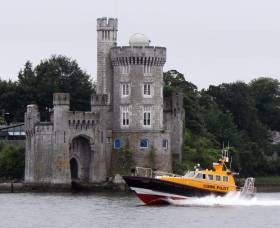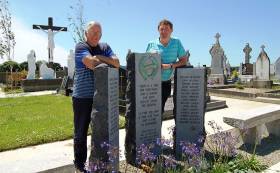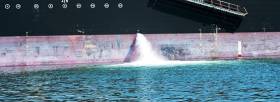Displaying items by tag: Tom MacSweeney
What Cork & Other Cities Should Do About Their Waterfronts
This Saturday will be a special one in Cork City when a fleet of boats sails up the River Lee from Cobh to moor at the uppermost navigable point of the river which yachts can reach. Cruisers and dinghies will race the traditional Cobh-to-Blackrock Race from the Promenade on the riverfront at Cobh to the Port of Cork’s marina in the city centre. This is an annual tradition. Once it marked the end of the sailing season, but as that has extended into much later in the year, the race has become also a social gathering when motorboats and non-racers join the fleet and families are on the water for the day out, organised by Cove Sailing Club.
It is, as Aidan McAleavy of the Cove club said, “a truly spectacular sight to see a large fleet race to the city.”
It made me wonder why Cork, my native city, hasn’t done more to develop the maritime location with which it has been favoured. The River Lee is renowned in the city’s anthem - The Banks of My Own Lovely Lee and the river endows Cork with a network of waterways as it breaks into different channels to negotiate the city centre. However, in all the development of Cork, I do not see that a lot has been done to bring the riverscape to the forefront of city planning, nor do all citizens appreciate the beauty of the river, it seems, to judge by debris still dumped into it. With its bridges and river channels Cork should be a city where the riverscape is its dominant aspect. As shipping and the port is moved downriver there is talk, a lot of it, about development, but not a lot about the city’s maritime foundation, which could be further forgotten when shipping is moved away from the city centre.
Other Irish cities still have shipping visible to the citizenry – Dublin in particular but that city’s Council hasn’t done a lot either to focus public facilities on the riverfront which the Liffey has provided them .. Waterford has put in some effort with a marina and quayside public facilities, as well as a memorial to the Conningbeg and Formby, both vessels sunk during World War One, with 68 passengers and crew lost from Waterford and the South East…. However, the movement of shipping out of the city has left derelict sites… Limerick has turned part of its face to the river…. Galway has done a bit, but the culture of the Claddagh could be more focussed upon.
All Irish cities could take lessons from European municipalities like Barcelona and Hamburg where the riverfronts are central to city life……. Wouldn’t it be an advance in maritime appreciation of City Councils held meetings to discuss waterfront enhancement?
• Listen to THIS ISLAND NATION Podcast here
Bellacrogher Boat Club, Ireland's Only Floating Clubhouse: Podcast
Seamus Butler is, to me, a man who embodies all that is good about sailing. He has a deep love for the sport, he enjoys it and teaches those values to young sailors, building the future of sailing.
I found him after driving to the western shores of Mayo, along the side of beautiful Clew Bay, through Mulrany following the Bangor-Erris Road, Achill Island across the water, to Bellacrogher Boat Club. There I parked, walked around the side of a lake to the Bay of the Plunderer, boarded a rigid inflatable and was taken out to the most unique clubhouse/classroom in Ireland, floating on the lake with its own pontoon and training area.
To tell you more would take from the superb interview which Seamus gave me and which I urge you to listen to below.
He is a man to be admired, as are the club members who have supported the development of this unique club which this Summer hosted Mayo’s first Hobie Cat Championships. They were even listed as one of the European events of the season!
Seamus puts a lot of emphasis on safety in the training of young sailors and the value of that is underlined in another item in the programme, when the Chief Executive of Irish Water Safety criticises – and quite rightly in my opinion – that only one-fifth of the country’s primary schools are teaching swimming and the importance of safety on the water to pupils, evidently because the majority of teachers consider other sports more important. He outlines worrying statistics about the high number of anglers who have drowned and warns about the increased use of kayaks without proper training.
Completing the mix of an interesting programme, you can hear why the national museum favours wheels to support its exhibits, why brides loves the light it provides and about the Round Ireland walker who has raised €25,000 for the RNLI, as well as a bit about the history of shanties.
You’ll enjoy listening.
Coastal Community Commitment – Podcast
There are moments and scenes which stand out in your mind. Stamped on mine is the day I went to a coastal village in West Cork and there, on the edge of a cliffside near Barryroe, close to Courtmacsherry Harbour, I saw the remains of a long-abandoned fishing family’s home, where two sons had died in the biggest sea battle of World War One – the Battle of Jutland on the thirty-first of May 1916. A short distance further up the same cliffside from that house, I was shown the home of another family whose son had died in the same battle. And, amazingly, in the parish of Barryroe, six men from the village had died in that sea battle, fought by a hundred thousand sailors in 250 ships of the British and German Navies. Eight thousand of those sailors were killed, including the six men from this village in West Cork. Another 29 sailors from Barryroe survived.
The interest of coastal communities in their history and culture, their pride in their heritage are impressive and are well underlined in this edition of my maritime programme, THIS ISLAND NATION, (click below for podcast) in the process of producing which I am fortunate to meet such communities.
In this edition I meet people from Courtmacsherry and Barryroe on the West Cork coastline and hear how they have researched and, as a result honoured, the amazing linkage between the area and the biggest sea battle of World War One – the Battle of Jutland, which is also described as the biggest sea battle ever. The statistics from it are, in terms of human destruction, terrible.
To walk into Lislevane Cemetery in Barryroe and see the memorial to those who fought and died at the Battle of Jutland is an emotional experience.
Government Delays For Five Years Signing Up To United Nations Treaty For Marine Environment Protection – PODCAST
Five years ago the Department of Transport told the United Nations agency dealing with safety at sea and the marine environment that it was preparing to ratify a treaty drawn up by the UN intended to control the spread of invasive marine species which could cause damage in Irish waters, possibly wiping out native marine species and causing damage to the marine environment generally.
Five years later, while 51 nations around the world have signed the Ballast Water Management Convention drawn up by the International Maritime Organisation, Ireland still hasn’t done so, despite a request from the Secretary General of the Organisation.
The treaty is designed to counter the threat to marine ecosystems caused by potentially invasive species carried across the oceans of the world in ships’ ballast water. Ballast water is essential to the safe and efficient operation of modern shipping, providing balance and stability to unladen and partly laden ships. Because shipping transports up to 90 per cent of the world’s traded commodities, it is reckoned to transfer up to 5 billion tonnes of ballast water around ports of the world every year and that is claimed by scientists to be the main cause of introducing non-native species from one country to another.
When Peru, this month, became the 51st State to accede to the Treaty to try to control this problem, I asked the International Maritime Organisation if Ireland had ratified…
“Not yet” I was told from IMO Headquarters in London, with the additional quote from their spokesperson… “but it is apparently intending to … Well that is what Ireland said in 2011” and they sent me a copy of Marine Notice No.47 of 2011 from the Department of Transport which stated that “Ireland’s maritime administration is at present preparing the legislation that is required and intends to ratify the Convention when this process is complete…”
Five years later, the IMO suggested to me that it might be worth asking why Ireland had not signed… I did and the Department told me…that “provision to give effect to the Convention was made in the Sea Pollution Miscellaneous Provisions Act of 2006. Now that’s ten years ago, but it seems a Statutory Instrument has been drafted by the Department to give effect to the Convention in Irish law. However, subject to some legal clarifications the Department expects that the Order will be enacted only …” shortly after the Convention comes into force…”
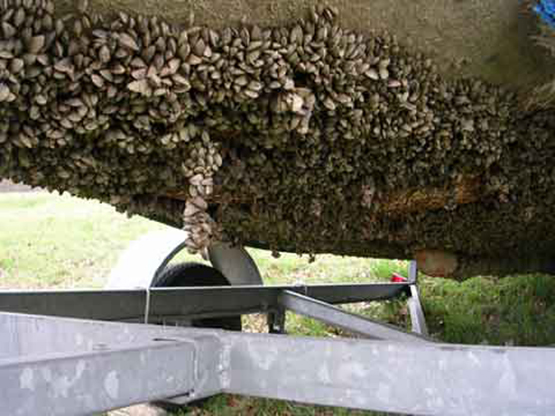
Zebra mussels on the hull of a boat
Thereby hangs the rub…This treaty has actually been hanging around since 2004, that’s 12 years ago, even as the problems of invasive species increased with specific threats identified in Ireland by Government task forces, to freshwater river systems, lakes and coastal areas. To come into effect it needs a minimum of 30 States to approve it which would represent 35 per cent of world merchant shipping tonnage. 51 States have done so but they represent only 44.87 per cent of tonnage. Ireland’s access would only add .02 per cent tonnage, but the Secretary General of the IMO has appealed to every nation to support the Convention… so why is Ireland delaying, saying that it won’t sign until the Convention comes into force… in other words waiting for other nations to support it while Ireland won’t?
Senator Grace O’Sullivan is the Green Party’s spokesperson on the environment and says Ireland could push the treaty along if the Government would sign it, while Richie Flynn, Executive of IFA Aquaculture on behalf of fish farmers, isn’t surprised by the failure to sign, but it doesn’t please him.
Hear their views and the Podcast above.
Sailing By & What You Didn’t Hear About Admiral Nelson
When that lovely piece of music, SAILING BY, rolls from the studio presentation desk through my headphones, I feel a sense of enjoyment at being able to bring a wide tapestry of news, information, stories about the culture, history and the maritime tradition to listeners so many of whom tell me that Ronnie Aldrich’s playing of the programme’s theme music on the LP ‘Sea Dreams’ sets the scene for them. I hope it does for you too because, sitting in the studios of Community Radio Youghal on the East Coast of County Cork, where the sea rolls in from Capel Island and other offshore points, my intention is to make a programme bringing together the maritime community. The response is encouraging and I am grateful to listeners who regularly suggest story lines. The current edition is my 46th programme from the radio studios in Youghal, a town with a huge maritime tradition. It was once the biggest port in the Republic. It was a town with a great schooner tradition, trading to the British coast. There were tragedies when families suffered great losses. The town was chosen as the location for the filming of the famous ‘Moby Dick’ epic. It has gone through a period of industrial decline. Every year it remembers those who have died at sea. It is again looking to build up its maritime resources. It has potential as a cruising port-of-call.
I have devised the programme as Ireland’s maritime programme, broadcast through the community radio service and on Afloat.ie to highlight the importance of the maritime sector to an island nation. The programme of news, stories and information from around the Irish coastline, rivers and lakes, connects the ‘family of the sea’ and relates this connection to the oceans of the world.
In the current edition we travel from Bloody Foreland in County Donegal where we hear about navigational changes noted by the Commissioners of Irish Lights, through connections in Offaly to Dublin Port’s famous Diving Bell and a new song about it by an Irish balladeer who has moved from Liffeyside to Holland. He gives us the honour of being the first to broadcast his composition. With a call to Cork to meet ‘the Irish father of ocean energy,’ and hear how he is concerned about lack of public knowledge of the value of marine energy, we are told a story that has not been mentioned in other media as they recall the blowing up of Nelson’s Pillar in Dublin 50 years ago. There is much more to know about Admiral Nelson as we hear how he defended an Irish revolutionary who wanted to kill the King of England. Together with reports from lifeboat stations around the country and the dominance of Clare in lifesaving, all of these stories make up the wide maritime tapestry of the latest edition of THIS ISLAND NATION which you can hear here.
I hope, like myself, that you enjoy this voyage around the maritime sphere of Ireland and, if you would like to contact the programme, the Email address is: [email protected]
Will Titanic Really Sail Again?
It is probably only an “eccentric billionaire” who would come up with and finance a plan to build a second Titanic and operate it with a derivative of the name of the company which owned the original ill-fated vessel.
Clive Palmer, the Australian billionaire and Member of Parliament, has been described as such and, though his original intention to have the second Titanic sailing this year has had to be postponed, he is still determined that it will voyage the oceans.
On this edition of THIS ISLAND NATION he and several of his supporters outline why they believe it is a viable project and will sail.

Construction of Titanic II in China
Clive Palmer, is the man who devised the plan for the second TITANIC and is paying for its construction, which will cost at least €200m. He says that TITANIC II will begin its voyages in 2018. Originally the date set for the inaugural sailing by the Blue Star Line, which he established for the project, was during this year. However, there have been difficulties and some setbacks in the project. The first sailing has been deferred for two years, while construction is underway in China.
The name BLUE STAR LINE contrasts with the WHITE STAR LINE which owned the original TITANIC.
BLUE STAR has announced that Titanic II will offer a “true period experience,” including the original type of cramped quarters for Third Class passengers, but better for 2nd and very good for 1st Class, just like the original vessel. It won’t have any ‘sinking feeling,’ according to Mr.Palmer. Unlike the original ship, there will be no shortage of lifeboats and it will have modern maritime safety and navigational, engineering and other technology. It will carry 2,000 passengers and have a lifeboat space for everyone aboard – unlike the original Titanic, which four days into its maiden voyage from Southampton to New York, hit an iceberg in the North Atlantic, about 400 miles from Newfoundland, on the night of 14 April 1912 and, gradually through to the morning of 15 April, sank. There were 2,200 passengers and crew aboard. 1.503 died in the sinking. The ship was built at the Harland and Wolff yard in Belfast.
Southampton has been included as a port-of-call for the inaugural voyage. So far no mention has been made of calling to Cork Harbour, last port-of-call for the ill-fated original vessel, where TITANIC took aboard Irish passengers who joined by tender from Cobh.
Tom MacSweeney
• Listen to THIS ISLAND NATION above
Battle for Cork Harbour & Fury Over Planned Incinerators
There is a battle beginning in Cork Harbour which could become nasty and how it turns out will shape the future of what has been described as “the second most beautiful natural harbour in the world.” At issue is €500m for development and centres that could lead the way in international maritime research.
The money has been earmarked for developing a maritime tourist centre on Spike Island, an international sailing development on Haulbowline Island and the Cruise Liner Terminal at Cobh, as well as the Beaufort Centre, leading international marine energy research and the Irish Maritime and Energy Resource Cluster, another research centre, both at Ringaskiddy, where the National Maritime College, also developing its international reputation is on the same complex. Close by is the Naval Base on Haulbowline.
In what seems like questionable planning logic, the waste management company, Indaver, where it wants to build not one but two incinerators, one to treat hazardous waste and another non-hazardous, just across the road.
In case anyone raises the NIMBY (Not In My Back Yard) issue, the vista of Cork Harbour, as residents will tell you, now includes three huge wind turbines used by the several chemical factories at Ringaskiddy and an increasingly noisy port where stacks of containers will be part of the scenery following the development of the new container port there. Ringaskiddy has, arguably, suffered more than any village in Ireland from environmental problems caused by the concentration of so many chemical factories there. What infuriates residents is that they have fought off Indaver for 15 years, involving legal action, Court cases and a cost of over a million Euros raised from the community.
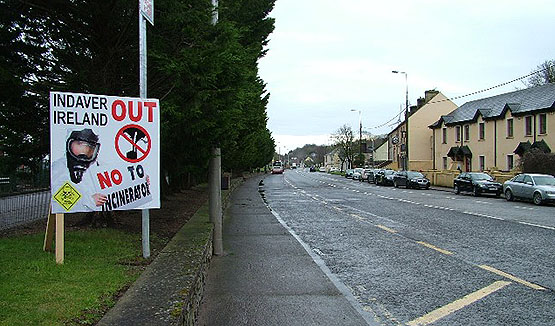
Incinerator protest sign at Ringaskiddy
That fury was evident on Monday night when several hundred crowded into Ringaskiddy Community Hall. So big was the attendance that people stood in corridors, entrances and even outside the building. Residents from communities all over Cork Harbour have voiced opposition and accused the company of trying to “bully their way” into the harbourside village. Minister Coveney, the Leader of Fianna Fail, Micheal Martin and other politicians have agreed with the residents that it is an abuse of democracy that a company can, as often as it wants, try to defeat the will of the people.
“I am fundamentally opposed to this development,” Minister Coveney told the meeting. He is a TD for the area, but got a hefty grilling about the incinerator proposal. He declared that he would object, as the FF Leader as other politicians have also pledged. He said he had told Indaver his views and that he feared their proposal would damage prospects for the €500m. investment in the harbour. “It is the wrong proposal, wrong place and wrong time and I say that as a person who loves Cork Harbour and has put a huge effort and time into trying to get what is right for it,” he said.
The battle now developing will have implications for sailing in the harbour and the clubs there, which include Cove, Monkstown Bay and the Royal Cork at Crosshaven. The new port could restrict the sailing area and the reputation of the ‘beautiful harbour’ could take a beating. The level of anger in the harbour is considerable.As I left the meeting on Monday night my last impression was seeing huge numbers of people queuing up to donate money to a campaign to stop Indaver and to lodge objections. Driving out of Ringaskiddy I saw the Minister for the Marine’s election poster proclaiming: “We’ll make Royal Cork great again.”
I wonder if that will happen, because it seems to me that a new ‘battle’ for the future of “the second most beautiful natural harbour in the world” is underway.
The Oldest Yacht Club in the World & The Membership Issue
My Podcast about membership of sailing and yacht clubs - GETTING MEMBERS IN – INSTEAD OF KEEPING PEOPLE OUT - drew a lot of attention and comment…. It seems to have touched a topic that quite a few people felt should be openly discussed……so it is appropriate that the oldest yacht club in the world, heading for its Tercentenary – 300 years in existence – considered the issue at its annual general meeting this week.
The out-going Admiral of the RCYC – the Royal Cork Yacht Club in Crosshaven - Pat Lyons, got directly to the centrality of the issue which is a problem for many clubs in sailing, though also not a problem exclusive to maritime sport.
While the club continues to attract new members, there is an on-going erosion of its long–term membership base, he said.
So, having congratulated the new RCYC Admiral, John Roche, on his appointment, I asked him if the club was any different from others around the country, facing membership problems. He takes over leadership of the RCYC for the next two years and told me that it was no different from any others in having to address issues of membership, with an ageing scenario also. A range of initiatives is being devised as a long-term strategy.
“These will benefit the club over time, placing our focus on remaining aware of and responding to, the evolving needs of the sailing community.”
Former Cork Port Harbour Master, Pat Farnan, was elected RCYC Vice-Admiral which places him in position to succeed to the office of Admiral in two years’ time.
Kieran O’Connell, who was re-elected as Rear Admiral Keel Boats at the RCYC agm, a tribute to his commitment and ability in running cruiser racing, is also Chairman of Cork Week.
John O’Connor is the club’s new Vice Admiral for non-racing cruising boats and Stephen O’Shaughnessy was elected to the role for dinghies.
Listen to the Podcast to hear the response of the oldest yacht club in the world to the membership issue and also about its plans for the Tercentenary in 2020 which are already being worked upon and the new competitions which will form part of this year’s Cork Week.
Getting Sailing Club Members In – Instead Of Keeping People Out
It’s annual general meeting time and for most sailing clubs one of the big issues will be membership. Some readers and club members may prefer the description ‘yacht’ clubs, but ‘Sailing’ was chosen by the national association a few years ago to popularise the sport. Many of the bigger clubs still remain YCs and there is nothing inherently wrong in that, provided that the description doesn’t keep potential newcomers away from the sport rather than encouraging them into it.
Exclusivity may be more in the eye of the beholder of clubs these days, from the outside, rather than within the clubs themselves but, whether or not you like it being mentioned, it remains an issue in some places and our sport could do without it.
I remember when Marine Correspondent with RTE being abused by a rather obnoxious member of a Dun Laoghaire waterfront club who emerged from its impressive paladial-like frontage to assail the camera crew and myself who were filming the premises from the roadway and being told by him that we should not be there and should realise the club wished to have privacy from the public. We were there at the express request of the club for coverage of a racing event, but this individual had decided to express his own view of the exclusiveness of sailing. While myself being involved in the sport, I could rather bluntly tell him what to do with his opinion, the camera crew were left with a bad impression of sailing.
‘Private – members only’ signage outside some clubs has been criticised, but clubs are entitled to protect their premises. There are golf clubs just the same, as are some other sporting establishments … but sailing seems to have been a particular source of criticism.
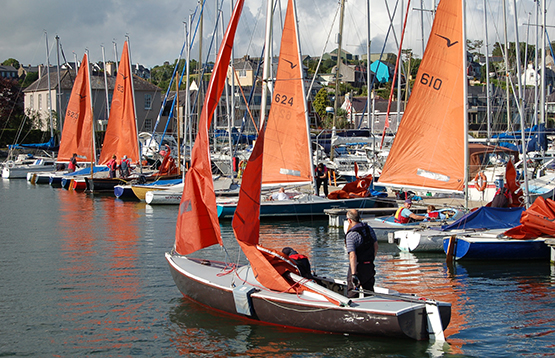 Sailing is a sport for life
Sailing is a sport for life
My media work has given me a access to clubs all over the country, so maybe I don’t experience what the general public does but it is reasonable to expect people to pay to become members and for the entitlement then to avail of the facilities provided. That is what a ‘club’ – a group or association of people with a common interest - is. Quite a few sailors are members of a few clubs. I am, of my village sailing club, Monkstown Bay, where I began in dinghies and also of the Royal Cork Yacht Club at Crosshaven. I went there for cruiser racing at a time when Monkstown sailed only dinghies. Nowadays it also races cruisers and I am happy to be a member of both….
While I have also experienced a welcome at clubs all over the country, it cannot be denied that the sport of sailing has an unfortunate legacy in a public impression left behind by a minority of individuals who did not represent it well, because they favoured exclusivity rather than inclusivity, which has to be the hallmark of the ‘sport for all …. and for life’ - which sailing should be in an island nation.
There is a challenge ahead for many sailing and yacht clubs as they hold their annual meetings – and that is to maintain their base of membership, much of which is ageing, so to encourage younger members and families to become and remain members and to get newcomers to join… thus ensuring the future of the sport….
Getting members in… instead of keeping people out….
If Old Boats Could Talk & Sounds of The Sea
At “the turn of the year” as it is still called by many of the older generation, it is customary to look back at the year past and remember a few high points. There were many for me in compiling THIS ISLAND NATION, but on this week’s edition of my radio programme, I have opted for unusual sounds which stuck in my mind about the sea.
70 percent of the earth’s surface is covered by water and still little is known about the treasures hidden in the deep sea. That was exemplified for me during the year when I played those unusual ‘sounds of the sea’ which drew a very big response from listeners.
I had never before heard the sound of the haddock, a fish which is popular on dining menus. Did you know that the haddock, which we eat, is actually capable of making audio sounds? I didn’t, but you can hear the sound which this fish makes on this week’s programme and there are other fascinating sounds, including from whales and dolphins. Perhaps they are attempts to communicate with the human world.
Who knows?
If they are such an attempt, whales will not be getting a positive answer from the Japanese who, as the New Year approaches, have sent two whaling ships to Antarctica's Southern Ocean to resume the killing of whales. This is under the pretence of collecting scientific data, which is not accepted as a genuine reason for whaling by the international community, including Ireland, where our waters are a whale sanctuary.
Japan has ignored International Whaling Commission regulations and has announced it will kill 333 minke whales this year, under the guise of being for research purposes. What that research is, has not been disclosed. Surprise, surprise in that regard!
In previous years Japan has killed 935 whales. Australia has said it will take action against Japan. It is really time that the Japanese stopped lie-ing to the world about the fact that they are killing whales for the greed of commercial interests.
There are times in one’s life when an incident is recounted which makes a big impact and so it is in the true story told this week by Dick Robinson about a time when youngsters on Valentia Island learned the hard facts of life at sea, when they were trying to make the transition from being youths to doing what they had seen men do. The “boys thought they were men….” Dick recalls about the tragic incident at ‘the top of the tide’ on Valentia which was a personal experience for him that left an indelible memory.

Valentia Island And The Top Of The Tide - A Story On This Island Nation. Click above to listen
It happened as a boat was being moved in the harbour and, as John Hollahan surmises on the programme - “If old boats could talk, what a tale they would tell….”
Amongst other topics on the programme, Myles Kelly of Fisheries Ireland outlines new bass angling regulations that are coming into force and discusses the start of the salmon season.
Do listen to THIS ISLAND NATION above on the Afloat website and, for the New Year ahead, may I wish you all …”fair sailing….”


























